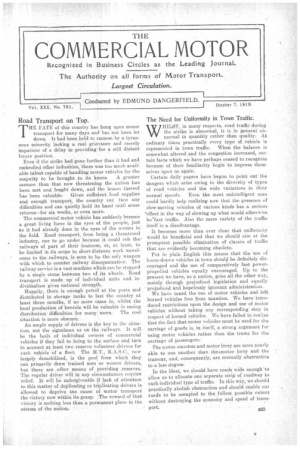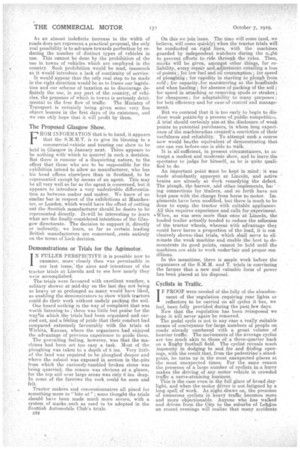COMM ERCIAL MOTOR
Page 1

Page 2

If you've noticed an error in this article please click here to report it so we can fix it.
Road Transport on Top.
THE FATE of this country has hung upon motor transport for many days and has not been let down. It had been held to ransom by a tyrannous minority lacking a real grievance and merely impatient of a delay in• providing for a still distant future position.
Even if the strike had gone further than it had and embroiled other industries, there was too much available talent capable of handling motor vehicles for the majority to be brought to its knees. A greater menace than that now threatening the nation has been met and fought down, and the lesson thereof has been valuable. Given sufficient food supplies awl enough transport, the country can face any difficulties and can quietly hold its hand until sense returns—for six weeks, or even more.
The commercial motor vehicle has suddenly become a great living force in the eyes of the people, just tis it had already done in the eyes of the armies in the field. Road transport, from being a threatened industry, one to go under because it could rob the railways of part of their business, or, at least, to be limited in its scope to short-distance work unwelcome to the railways, is seen to be the only weapon with which to counter railway disorganization. The railway service is a vast machine which can be stopped by a single stone between two of its wheels. Road transport is made up of individual units and individualism gives national strength.
Happily, there is enough petrol at the ports and distributed in storage tanks to last the country at least three months, if no more came in, whilst the local production of benzole will be valuable in easing distribution difficulties for many users. The coal situation is more obscure.
An ample supply of drivers is the key to the situation, not the signalman as on the railways. It will be the fault of indiVidual owners of commercial vehicles if they fail to bring to the surface and turn to account at least two reserve volunteer, drivers for each vehicle of a, fleet. The M.T., R.A.S.C., now largely demobilized, is the pool from which they can primarily draw trained men or women drivers, but there are other means of providing reserves. The regular driver will in any circumstances require relief. It will be miforgiveable if lack of attention to this matter of duplicating or triplicating drivers is allowed to deprive tan cause of motor transport the victory now within its grasp. The reward of that victory is nothing less than a permanent place in the . atoein of the nation.. : The Need for Uniformity in Town Traffic.
WHILST, in many respects, road traffic during the strike is abnormal, it is in general abnormal in quantity rather than quality. At ordinary times practically every type of vehicle is represented in town traffic. When the balance is somewhat altered, and the congestion increased, certain facts which we have perhaps ceased to recognize because of their familiarity begin ' to impress themselves upon us again.
Certain daily papers have begun to point out the dangers which arise owing to the diversity of types n of road vehicles and the wide variations in their normal speeds. Even the most unintelligent man could hardly help realizing now that the presence of slow-moving vehicles of various kinds has a serious 'effect in the way of slowing up what would otherwise befast traffic. Also the mere variety of the traffic itself is a disadvantage.
It becomes more than ever clear that uniformity would be beneficial and that we should aim at the promptest possible elimination of classes of traffic that are evidently becoming obsolete.
Put in plain English this means that the use of horse-drawn vehicles in town should be definitely discouraged and the use of comparatively fast powerpropelled vehicles equally encouraged. Up to the present we have, as a nation, gone all the other way, mainly; through prejudiced legislation and equally ' prejudiced and hopelessly ignorant administration.
We have taxed the use of motor vehicles and left horsed vehicles free from taxation. We have'introduced restrictions upon the design and use of motor vehicles without taking any corresponding step in respect of horsed vehicles. We have failed to realize that the fact that motor vehicles must be used for the carriage of goods is, in itself, a strong argument for using motor vehicles rather than the trams for the carriage of passengers.
the motor omnibus and motor lorry are more nearly akin to one another than the i.motor lorry and the tramcar, and, consequently, are mutually obstructive to a less degree.
In the ideal, we should have roads wide enough'to allow us to allocate one separate strip of roadway to each-individual type of traffic. In this way, we should practically abolish obstruction and should enable our roads to be occupied to the fullest possible extent without destroying the economy and speed of trans port. . As an almost indefinite increase in the width of roads does not represent a practical proposal, the only real possibility is to advance towards perfection by reducing the number of distinct types of vehicles in use. This cannot be done by the prohibition of the use in towns of vehicles which are employed in the country. Such prohibition would be mad, inasmuch as it would introduce a lack of continuity of service. It would-appear that the only real step to.lae made in the right direction -would be so to frame our legislation and our scheme of taxation as to discourage definitely the use, in any part of the country, of vehicles, the presence of which in towns is seriously detrimental to the free flow of traffic. The Ministry of Transport is certainly being given acme very fine object lessons in the first days of its existence, and we can only hope that it will profit by them.
























